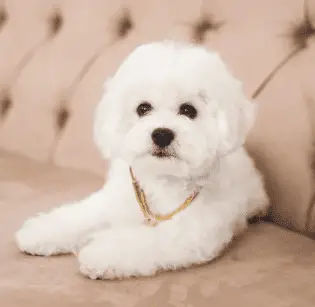The History of the Cavachon
Our website is supported by our users. We sometimes earn money when you click an affiliate link and make a purchase. This is at no extra cost to you and helps us to create quality content. Thank you so very much for your support.
The Bichon Frise and the Cavalier King Charles Spaniel, two highly well-known purebred small dog breeds, were crossed to create the Cavachon.
The Cavachon is a relatively new breed and as sweet tempered dogs, that look like a teddy bear, they make the perfect companion and are great family dogs.
It is a great dog for people who live in confined spaces in cities where outdoor dog potties can be built on balconies and terraces of high-rise buildings.
The Cavachon dog is not recognized by the American Kennel Club due the fact that they are not purebred dogs even though they can descend from two purebred parents.
In fact, the Cavachon is a designer breed, or in other words, they are mixed-breed dogs.With any mixed breed, dog owners hope get the best traits of each dog.
Let’s look at the two parent breeds that the Cavachon is bred from.
Bichon Frise

This little white dog is a member of this canine family more properly referred to as Barbichon-type dogs, which is an all-encompassing term including breeds such as the Bolognese, Havanese, Maltese, and Bichon Frise.
On Tenerife, the largest of the Canary Islands, these breeds are believed to have started their contemporary development. The small Bichon Tenerife dog, which was quick, astute, and attractive to the eye, like a cotton ball, evolved into the main ancestor of the modern Bichon Frise.
As smart and wonderful companions, the Bichon Frise is said to have been introduced during the Renaissance period and was a favorite of royals in France, Spain and Italy. It’s even included in many oil portraits including the works of Titian all the way to centuries later in a painting by Renoir.
It appears to have arrived in the United States in 1956 with Helene and Francois Picault of Dieppe of France, hoping to establish the Bichon Frise as recognized breed. They began breeding and in 1973 the Bichon Frise was recognized by the AKC.
Bichon Frise puppies are full of energy and a lot of fun. With their button noses and round eyes, they make a great first impression. These dogs come in a wide range of colors, from white to combinations of white, cream, and apricot. Most weigh between 12 and 18 pounds and measure 9.5 to 11.5 inches.
Cavalier King Charles Spaniel

Another favorite of royals, the Cavalier King Charles Spaniel has been around since the 1600s during the rule of King Charles I and his son King Charles II century and were also prominently featured in art.
In the 1800s breeding had led to the CKCS becoming almost unrecognizable and contests were held to return the breed to look more like the paintings depicting them from prior centuries. Though some believe that it was done by inbreeding, others believe that other dog breeds were introduced to bring the CKCS back to it’s former state.
The first Cavalier King Charles Spaniel came to the US in 1952 and wasn’t recognized by the AKC until January 1, 1996.
Appearance

As mixed breed, it is difficult to predict just what the puppies will look like. Some puppies may favor either of their two breeds or they will be the perfect, adorable mix of the two with a curly coat. They may have the fluffy, springy hair of the Bichon Frise or the longer, silky coat of the Cavalier King Charles.

As a designer dog, the Cavachon’s coat can contain the white, brown, black or red of the Cavalier King Charles or the white, cream and apricot of the Bichon Frise. They may contain any color combination of the two.
Though again, it depends on genetics, Cavachons have a height of 9-13 inches (23cm-33cm) or so and weigh between 15 and 35 pounds (7kg-16kg).
It is good to note that these little dogs are known to have a hypoallergenic coat. Even if the chances of an allergic reaction are greatly reduced, some allergy sufferers could still react while near a Cavachon.
Temperament of the Cavachon
A long-time favorite companion dog to royal families, the Bichon Frise and the Cavalier King Charles Spaniel breeds are a frequently bright, amusing dogs that are generally happy and have a gentle nature. As a mix of the two, Cavachons make great family pets and get along great with young children as well as other canine friends.
These beautiful dogs do have a sufficient energy level, so it is a good idea to take them on walks at least several times per week.
If you want your Cavachon puppy to develop into a smart and obedient family member, early socialization is essential. Some may exhibit traits inherited from their Cavalier ancestors, such as a love of chasing after small animals, especially when taken for walks in the dog park or the woods.
The Cavachon breed’s lack of hostility is one of its best qualities and that makes them a good family dog. However, they may have a tendency to be a little possessive and may bark at strangers, but they hardly ever try to harm humans or other dogs. Overall this still makes them great additions to any family.
Cavachons become intensely bonded to their owners and are unable to spend extended periods of time alone. Many owners choose to have two Cavachons that keep each other company since they get along well with other dogs.
Cavachon Common Health Issues
Mixed breeds are generally healthier because it is more possible for the puppies, with a larger gene pool, to get the better genetics. Pure bred dogs tend to pass down the genetic disorders from generation to generation.
However, there is still a chance that genetic disorders can be handed down. Let’s look at the two breed parents to get an idea of the possibilities:
The Bichon Frise

Kidney Stones
Compared to other dog breeds, this breed can have a higher incidence of kidney and bladder stones. Dogs with kidney stones typically don’t need to be treated until they clog the ureter. If this occurs, surgery is required to stop any additional consequences, like kidney failure.
Some canines may not exhibit any symptoms of kidney stones, and those that do may show signs of a urinary tract infection. These include urinating blood, licking at their private parts, losing their appetite, becoming lethargic, and experiencing abdominal pain.
Please consult your vet for the proper diet for your dog. Also, make sure that they have access to plentiful and clean water.
Hip Dysplasia
In Bichon Frise, the elbow dysplasia is fairly common. This problem arises when the ball and socket of the joint do not line up properly, leading to excessive wear and strain. At some point, although much sooner than is typical for arthritis, this leads to symptoms that resemble arthritis.
This injury normally occurs to the dog while it is still a puppy and developing, however it is possible that it won’t become apparent for several years.
This is where responsible breeders come in. You will have to rely on the ethics of a good breeder in order to make sure your Cavachon puppy’s Bichon Frise parent is healthy.
Portosystemic Shunt
In comparison to other breeds, the Bichon Frisé is more susceptible to portosystemic shunt (PSS), a liver condition.
Normally, there is a portal vein which feeds unfiltered blood to the liver for cleaning.
PSS occurs when the vein has bypassed the liver, allowing the poisons to flow in the body and enter the main blood circulation.
Symptoms will include being underweight, poor weight gain, increased thirst and urination, vomiting, diarrhea, difficulty urinating (if a bladder stone has developed) and seizures.
Medication and a special diet may be prescribed by your veterinarian to treat the symptoms of the illness. However, to alleviate the problem more permanently, surgery may be required.
Diabetes
According to the CDC diabetes is:
With diabetes, your body doesn’t make enough insulin or can’t use it as well as it should. When there isn’t enough insulin or cells stop responding to insulin, too much blood sugar stays in your bloodstream. Over time, that can cause serious health problems, such as heart disease, vision loss, and kidney disease.
The signs that your dog may have diabetes are excessive water drinking and urination, weight loss, an increase or decrease in appetite, cloudy eyes, and recurring infections (skin and urinary), lack of energy, vomiting and depression.
Your veterinarian can diagnose your dog to determine whether diabetes can be managed through diet, medication and or injectable insulin.
Legg-Calve-Perthes
Bichon Frises are more susceptible to Legg-Calve-Perthes than other breeds of dogs, and symptoms typically manifest in the early stages of a puppy’s life. This disorder causes the femur to degenerate and shrink because blood does not flow as it should to the head of the thigh bone.
Legg-Calve-Perthes disease, which often affects just one limb, is extremely painful, and limping is almost always a symptom.
Femoral head and neck ostectomy (FHO), or surgical removal of the femoral head and neck, is the preferred course of treatment. Replacement of the hip joint is usually not essential because the problem commonly affects young, small breed dogs.
Luxating Patella
Common to small breeds, when the kneecap shifts out of the groove it is intended to stay in, it is known as luxating patella. Inflammation, irritation, soreness, cartilage damage, and ligament tears can result from the knee slipping.
The symptoms might range from being able to bear no weight at all to being able to hold up the affected leg for a few steps, depending on the severity of the ailment.
Sometimes manipulation of the leg can help the patella back into place. When it happened to our Pomeranian, this is what we did: With the dog lying on it’s unaffected side, gently grasp your dog’s foot and push your dog’s leg in a circle but still flat, almost as if they were riding a bike while still on their side.
Do this VERY gently and somewhat slowly. You don’t want to do it too quickly but super slow can prolong the pain and may not let the kneecap pop back into place like it needs to.
It worked for our dog, but as always, ask your vet if it is the proper way to handle your dog’s luxating patella.
In most cases, anti-inflammatory medication, weight management and exercise restriction are common. But in more extreme cases surgery may be necessary.
The Cavalier King Charles Spaniel

Mitral Valve Disease
With this disease, the mitral valves in a CKCS are excessively short and thickened. Accordingly, the one-way door cannot completely seal, enabling blood to seep back into the left atrium. The “whooshing” and “shwishing” we perceive as a dog’s heart murmur is brought on by this irregular blood flow.
MMVD may eventually result in congestive heart failure (CHF). This occurs when the heart becomes too frail to force the blood in the proper direction, resulting in an accumulation of extra fluid in the lungs.
Ear Infections (Otitis)
Dogs with floppy ears that fold down over the ear canal are more prone to have ear infections than dogs with small or upright ears. The warm moistness of the ear canal makes a hospitable location for molds, bacterias, and pests to reside.
The CKCS is no exception. Their beautiful ears are a common feature for this dog. These can be a result of bacteria, allergies, mites, polyps, overproduction of ear wax or from water getting trapped in their ears from bathing or swimming.
When your dog has an ear infection they may whine, paw or scratch at their ears and shake their heads frequently. You may see redness of the ear canal and it may have a foul odor.
Luckily, the infections are usually treatable with prevention, cleanliness and medication. Without treatment your dog could develop hearing loss.
There are over the counter treatments for ear infections, however, your vet will be able to give you the correct medication.
Prevention is recommended by making sure your dog’s ears are dry after swimming, bathing or even walks in the rain. Regular cleaning will prevent ear wax build up.
Syringomyelia
Syringomyelia (SM) is a condition in which, due to an abnormality where the skull joins the vertebrae, the spinal cord develops cavities and fills with fluid as a result of excessive pressure inside the skull. According to NIH.gov, SM is present in 50
Common symptoms include: Yelping when moving, frequent scratching at head and neck due to pain (aka Phantom Scratching), weakness in limbs, having a wobble as they walk are all common symptoms of syringomyelia.
Syringomyelia, sadly, cannot be cured. However, pain can be managed through pharmaceuticals and if necessary, surgery.
Atopic Dermatitis
Dogs and cats can develop the itchy skin condition known as Atopic Dermatitis.
When an animal with this illness consumes an item they are sensitive to or inhales airborne substances (pollen, house dust, dust mites), they experience an allergic reaction. The animal rubs, licks, bites, or scratches as a result of the allergic reaction.
If you see your dog doing any of these, consult with your veterinarian for diagnosis. Usually, allergen therapy and medication will be prescribed.
Luxating Patella
The King Charles Cavalier Spaniel is also prone to these. With both breeds having the possibility of patellar luxation, you can probably bet that your dog will probably be afflicted with it.
That said, knowing this, you will be more aware of and on the lookout for the symptoms.
As mentioned, the luxating patella refers to when the kneecap moves out of the groove it is supposed to remain in. The slippage of the knee can cause ligament tears, cartilage damage, inflammation, discomfort, and soreness.
Depending on the severity of the condition, the symptoms may range from being unable to support any weight, on their back legs at all, to being able to hold up the affected leg for a short distance.
Our dog would yip and roll around in pain so it was easy to spot.
Anti-inflammatory drugs, weight management, and exercise limitation are frequently used. But in more severe circumstances, surgery might be required.
Grooming your Cavachon

Though considered low maintenance with low-shedding coats their coat needs regular, weekly brushing. Optimally, it is best to brush your Cavachon two to three times a week.
At least occasionally, it may also be necessary to trim the medium-to-long curls (if your dog has them).
As with any canine, you will need to trim your dog’s nails regularly to maintain your dog’s ability to walk correctly and avoid the problems associated with a luxating patella.
If you choose use a groomer, many of them require that your dog be done with its last shots but encourage you to begin grooming as early as possible so that they are less anxious about it as adults.
Despite the fact that the breed is regarded as a mild shedder, if you opt not to take your dog to the groomer, it is advised to bathe your Cavachon once per month or once every six weeks.
In order to prevent eye disorders like conjunctivitis, the hair surrounding your dog’s eyes must be carefully clipped. By pulling the hairs away from the eyes using a damp cloth, unscented baby wipe or cotton pad, you can clean your dogs face gently between bathings.
Training Your Cavachon

To acclimate a Cavachon puppy to other people, Cavachon owners need to begin training and socialization as soon as feasible. Although this breed has a medium degree of energy and doesn’t need much exercise, obedience training should be used to make sure that your puppy develops into an intelligent adult.
Train your dog companion to: walk on a leash; greet people formally; and react to their name. Positive reinforcement training is the best way to train these sweet-tempered dogs.
This specific breed responds well to praise and rewards, but you should avoid overdoing it with treats because small dogs are prone to obesity.
Two or three 10-minute training sessions each day are preferable than a single 30-minute session in terms of frequency. Even after your Cavachon has reached adulthood, you will need to continue to reinforce their training to avoid negative habits developing.
Due to their small size, Cavachons will take more time and patience when being trained to go potty. In the first few weeks, be prepared to take your puppy outside regularly.
Setting a timer for once an hour can help eliminate accidents. However, they do still occur.
When this happens, it is best to use an enzymatic cleaner as dogs tend to continue to go in the same place and they locate this place more by smell than memory. The enzymes in the cleaner neutralize the proteins so that can’t smell the spot anymore.
Read more about this in the article from MSN, How To Get Pet Odors Out Of Your Home, According To An Expert, where our head writer and AKC dog trainer, Michelle Lehr, tells us how to keep your house from smelling like your best friend.
We have several articles on dog training that you may want to take a look at for help. One is How to Take Care Of a Puppy and another is How to Potty Train Your Dog.
Adopting a Cavachon

You’re making a long-term commitment if you want to get a Cavachon puppy as they have a life span ranging from 10 to 15 years.
The cost of purchasing a Cavachon is higher than that of many other breeds, though. Both Bichon Frise and Cavalier King Charles Spaniels are sometimes over $1,000 in price.
Some breeders may offer Cavachon puppies for sale for as little as $700 or $800. However, being on the low end, you may want to reconsider. Breeders charging a lower rate for a puppy may not be as reputable and may be breeding dogs with extensive health issues.
You should prepare to spend anywhere between $2,000 and $6,000 or more if you want your Cavachon to come from a good line from a reputable breeder.
As with all dogs, since they are likely to suffer from some health problems at one point or the other, you might have to be prepared for some expenses beyond regular check-ups and treatments.
FAQs about the Cavachon
Do Cavachon dogs bark a lot?
Though many small dogs are notorious for being yappy, the Cavachon is much more mild mannered and less excitable. They do tend to bark at strangers so when they do bark, it is quite useful.
Do Cavachon dogs shed?
Cavachons are not known to be heavy shedders. Their coat is medium length, tight and wavy.
What are pros and cons of Cavachon?
The best qualities of both dog breeds can be combined in Cavachons, including their laid-back attitudes and low-shedding coats. They might, however, inherit negative traits like separation anxiety and health issues like the luxating patella that is present in both breeds.
The Bottom Line on the Cavachon
Cavachons are fun and loving companions that are affectionate and do well in small spaces like apartments and need moderate exercise. So they are great options and a good fit for city dwellers.
Unfortunately, they do not do well alone for long periods of time and suffer from separation anxiety. Also, they may have expensive heath issues.
Also, if you want a dog for protection and security, Cavachons will not fit your needs as good guard dogs as they usually have a sweet personality and are friendly dogs.
As always, before purchasing, we encourage people to check with their local shelters and humane societies for Cavachons that may have been surrendered.
However, if you insist on purchasing, please do your research on a reputable Cavachon breeder. A low price may mean that the breeder is not as reputable as you would like and may produce a dog with a lot of health problems.
It goes without saying, even though we are saying it, that the money you save in buying the dog may result in 10 times that in vet bills. Choose wisely.
Please read our Legal Disclaimer

